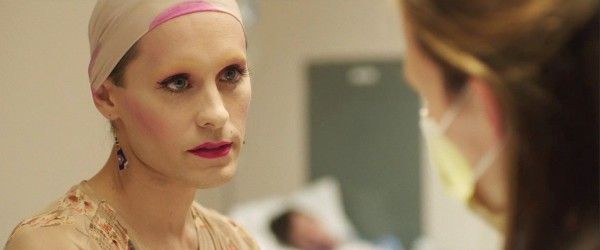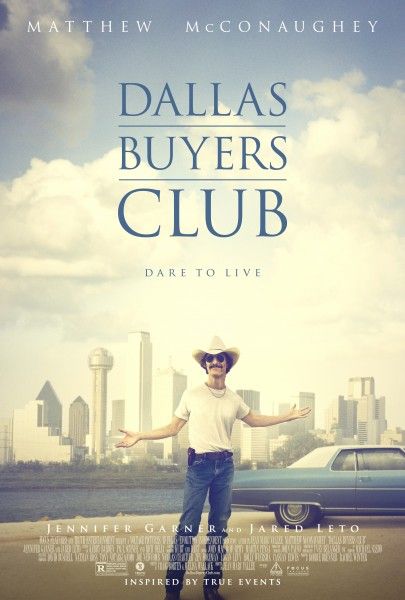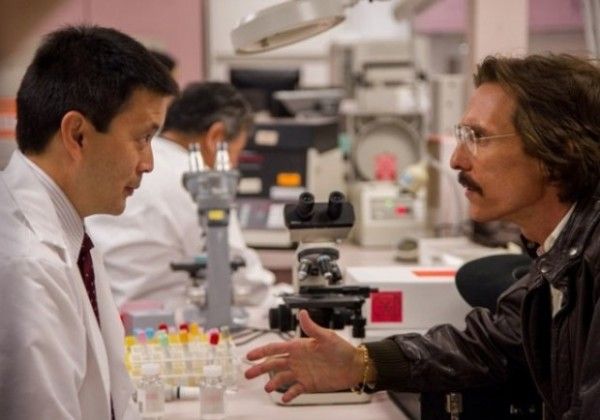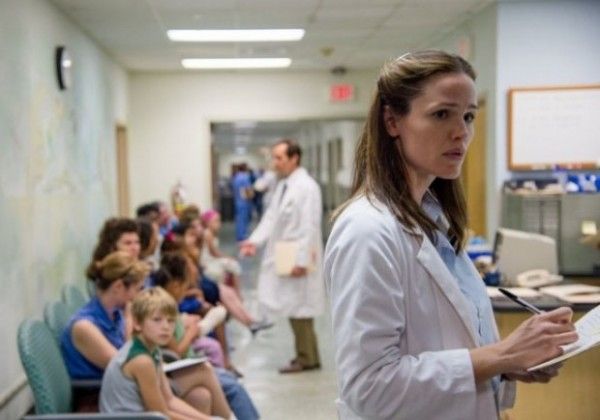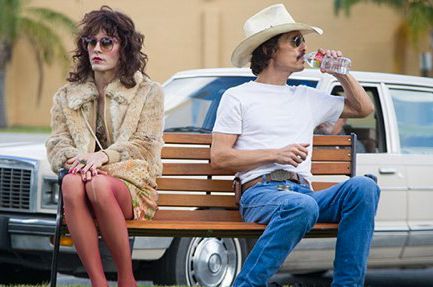Montreal-born filmmaker Jean-Marc Vallée has always been drawn to character-driven material that’s emotional and inspiring. His strong sense of storytelling through imagery is evident in his new film, Dallas Buyers Club, based on the real-life story of Texas cowboy turned AIDS activist, Ron Woodroof (Matthew McConaughey). Shooting the movie 100% handheld with available light, Vallee’s visceral direction enhances the richness of character and raw emotion in this drama about an imperfect man who was given a death sentence but was determined to beat the odds. Now playing in limited release, the film also stars Jared Leto and Jennifer Garner.
At a recent roundtable interview, Vallée talked about looking for the humanity in the story, his directorial approach, wanting to tell a story that’s faithful to Woodroof, finding the balance between seriousness, comedy and respecting the facts, what McConaughey brought to the role and how his way of working took Vallée out of his comfort zone, his homage to Frank Capra’s It’s a Wonderful Life, how the film evolved in the editing room, the moving supermarket scene between Ron and Rayon, and his new project, Wild, starring Reese Witherspoon based on Cheryl Strayed’s best-selling memoir. Hit the jump to read the interview:
QUESTION: Compassion and passion are what really comes forth in this film and it’s something so different from what we’ve seen before from you.
JEAN-MARC VALLEE: If you look at C.R.A.Z.Y. and Café de Flore, and even in Young Victoria, there is always humanity. I think I’m looking for a beautiful humanity in this story, in the subject and the stories. So when I read the script, it was there just like the other projects that I selected before.
This one has a much more visceral truth to it and it could be because of the vibrancy of Ron’s life.
VALLEE: Yeah, and maybe because of the directorial approach of shooting available light, no electric crew, no grip crew, no lighting. The production designer was lighting the film with his practicals. We were using a handheld camera and just trying to be raw and serve the story of this underground underdog guy. At the same time, the challenge was to serve the emotional content, to be there and try to tell this beautiful emotional story. When I was reading the script the first time, I was deeply moved and my eyes were wet. I was like, “How can I do this?” At the same time, the subject matter is so serious. How can we get out of that, and smile and laugh and have fun, and don’t go there and try to make people cry and be too serious? The screenwriter had already addressed this concern, and I came in, and I put some Marc Bolan in him and made Rayon a T. Rex fan, and tried to get some humor with Ron in this strip joint making a prayer just to have fun also with this. That’s life and it’s not always serious, but it’s not just a comedy. And then, in the cutting room, it was about finding the right balance between seriousness, comedy and respect for the facts. At the same time, the only real character in this film is Ron. The other characters around [him] were all created by the screenwriters, but the story is true to Ron and faithful to the guy who did that. He was a crazy guy.
I definitely appreciated your approach. Most films we’ve seen about H.I.V. and AIDS are tragedies or they’re overly sentimental, but this is less about dying and more about living. Why is this the story that you wanted to tell?
VALLEE: To me, it’s the life lesson behind it. I mean, when you’re told you’ve got 30 days to live, what do you do with them? “Oh yeah? There’s nothing out there that can kill me in 30 days. You watch me.” The guy has no education. He becomes his own teacher, expert and lab rat. He had some balls. He was a crazy cowboy who wanted to live. “You’re not going to tell me I’m gonna die. No way. You watch me. I’m gonna live.” If he wasn’t that stubborn, maybe he could have lived longer, because the research proved that AZT worked at a certain dosage and that’s the sad thing. But just like the gay activist in a lot of clubs, he made a difference. It was a tough time with regulations and protocols. We were concerned. We didn’t want to present the FDA and the doctors as the villain in the film. Denis O’Hare is not the bad guy, and the FDA guy is not the bad guy. They’re humans. They believe they’re doing the right thing, and they were doing the right thing, but they just didn’t know and people were dying. It took time and it was tough. It took until 1996 before the pharmaceutical companies, the government, the doctors, and the activists all worked together and said, “We’ve got to find something,” and they found it with the anti-retroviral therapy.
The strip club scene has that great reversal with him starting out praying because the lights make him think he’s in a church. Your last film, Café de Flore, took audiences on a spiritual journey. Were you looking for a similar journey here or was this a welcome departure?
VALLEE: No. I would say it’s a new thing, although I like to try to give a little bit. I’m always aiming for some magic in films if I can find a mystical quality either in a song or in a moment or a character’s intention. I wonder if Ron believes in God. It’s just so awkward to see this guy praying, and when you’re confronted, too. C’mon. He didn’t know. To me, that was my homage to Frank Capra and It’s a Wonderful Life. You’re at the end of your rope. “Show me the way. I’m at the end of my rope.” And he’s hiding himself just through words. He’s hiding himself in a bar. And the response to his prayers is a punch in the face. So here he’s in a strip club and the directorial approach was to tell this story from this guy’s point of view. What he hears is what we hear. So, we’re in his head right now, and he’s not hearing the music or only very distantly. He’s hearing this buzz during the film so I could cheat and tell the audience that we’re not in the strip club right at the beginning because we’re with him. So that cheat was okay. And then, he’s done with the prayer and bang it reveals the strip club. Honest son of a gun.
Can you talk a little bit about what Matthew brought to the role and why he was the right actor to play that character?
VALLEE: It’s like, was there another person to play that character? First, this guy’s from Texas. He was my Texas 101 teacher. What he brought to the role is his humanity, because with McConaughey, after five minutes, I don’t think it’s acting, and the audience is with this guy and cares for him. I’ve seen the film three times with an audience so far, and in the first 20 minutes, this guy is an asshole. You’re not supposed to care for him. So how come after 5 minutes in a room I can feel that? And they’re laughing and they care. So this is more about the person, what he portrays. We like this guy. This guy has such goodness and humanity, even when he portrays a guy who’s having sex with two girls, steals from his friends, punches a cop, and is racist and homophobic. And then, his arc is going to change slowly but surely without him even realizing it or wanting it. He’s going to become the spokesperson of the gay community that he’s been bashing for years and years. So that’s what he brought naturally.
And then, there was his way of working which you saw just with the weight loss. He took me out of my comfort zone. He was in movement. “Texas is movement, Jean-Marc.” “Yeah?” I’m from the less is more school and I’m trying to [do that]. “Can you give me a less is more take, please Matthew?” And he was just…and Jared was… “Jesus, what the hell am I doing with this?” So they were giving me that sometimes, and I was like, “Okay.” And my reaction on the set was to pull away and change the lens. I want to shoot them wide. I’m afraid of these guys. I’m not going to go there. So I very rarely went there. And to my surprise, in the cutting room, most of the time I used the “more is more” takes rather than the “less is more” takes that I was asking from them. But, the more is more takes were shot from a distance. So my job was to find the right distance. On the set, I wasn’t sure. So I was covering myself with, “Okay. I’m going to go there, and maybe I’ll go there, and at the end, maybe there, closer.” And then, in the cutting room, it became obvious. Okay. Stay away. Don’t interfere. Don’t cut too much. It’s about when you read the script, you were crying. There was no acting yet, no directing. Just trust that. Trust the acting. If you look at the film, there are not a lot of cuts when they’re doing the emotional moments. And then, of course, I’m having fun with some cuts here and there playing with this big toy. It’s so great. So we’re in the dark for two hours with sound and images and music and silences. What a great ride. What a great time.
What moved you most about Ron and Rayon’s experience together as the film progressed?
VALLEE: I think the supermarket scene. There was something so unsaid, untold, without using words, when they’re doing their thing, and the way Rayon looks at Ron. From there, I think it becomes obvious that this is a love story between two guys. And we’re not telling that. And it’s not really about that. But it is that. These guys love each other and learned to love each other. And from that moment, it’s like a love story. Oh my God, don’t tell me they’re going to love each other. At one point, I was asking myself, “Should we give a hint to the audience that maybe they’ll have sex together or something just to give…?” In the cutting room, I tried [something] with this scene in the motel room when he is with the whore, because Rayon died and he’s drinking again and doing cocaine, and this girl is there and he was looking at her. In the cutting room, I put some quick flash of Rayon, just a little peak at Rayon, but it didn’t work.
What was the mood like on set when they weren’t eating and had lost so much weight? Were you guys trying not to eat around them?
VALLEE: No, not at all. That was their thing and they were okay with the crew and everyone. We just ate like normal and they were okay with it.
What are you working on next?
VALLEE: I just finished my first week of shooting. I’m shooting in Oregon. It’s a film called Wild from the book Cheryl Strayed wrote and starring Reese Witherspoon. That’s why I look so tired.

